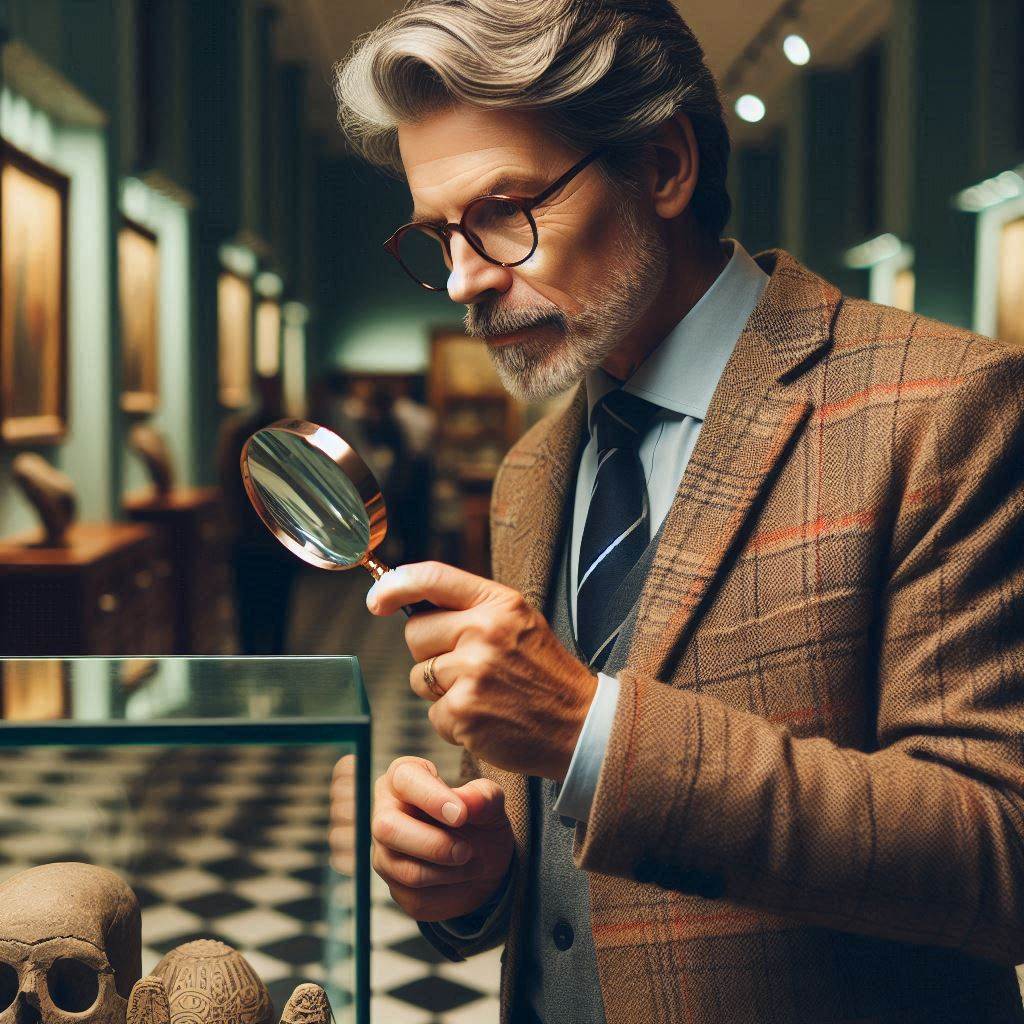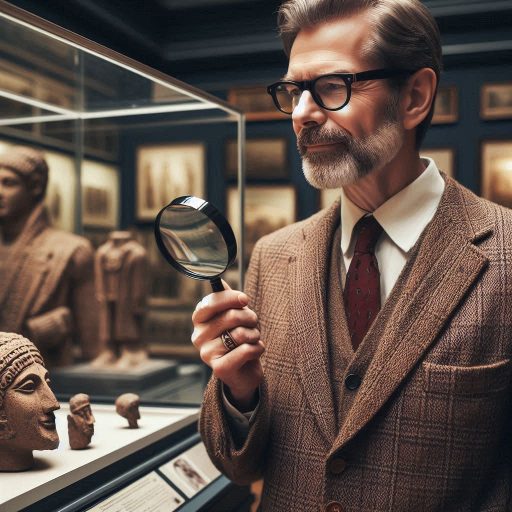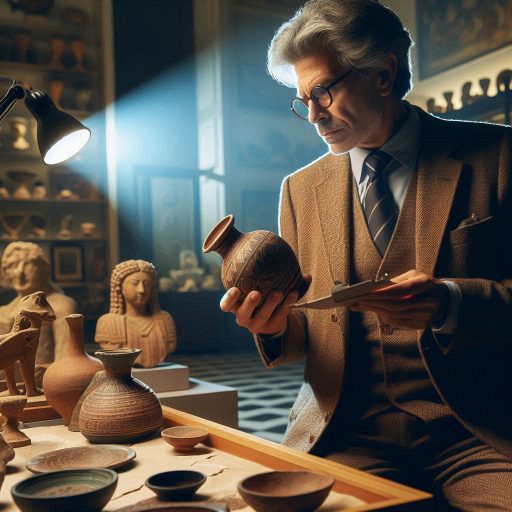Introduction
A museum curator plays a vital role in managing and preserving collections of historical, artistic, or scientific significance.
They are responsible for organizing exhibitions, conducting in-depth research, and engaging with the public to enhance appreciation for the collections.
Museum curators often work within larger institutions that have extensive collections, developing educational programs to provide context and meaning to the artifacts on display.
They collaborate with various departments, including education, conservation, and marketing, to ensure that each exhibition resonates with visitors and fulfills the museum‘s mission.
In contrast, a gallery curator specializes in managing art galleries that showcase contemporary art.
Their primary responsibilities include selecting artworks for exhibitions, working closely with artists to understand their vision, and promoting these works to potential buyers and the public.
Gallery curators often engage in marketing and sales, balancing artistic integrity with the commercial aspects of exhibiting art.
They aim to create an inviting atmosphere that fosters dialogue between artists and audiences.
This blog post aims to explore the key differences between museum curators and gallery curators.
By understanding these distinctions, aspiring professionals can make informed career choices.
Education and Background
Museum Curator: Typically Holds a Graduate Degree in Museum Studies or Art History
Museum curators generally hold advanced degrees in museum studies or art history.
This academic background equips them with a deep understanding of artifacts, historical contexts, and preservation techniques.
Graduate programs focus on various aspects of museum management, including conservation, education, and exhibition design.
Museum curators often specialize in specific areas, such as contemporary art, archaeology, or cultural heritage.
Their training emphasizes the importance of research and curation in preserving cultural artifacts.
A museum curator‘s role involves not only selecting artworks for display but also conducting extensive research on each piece.
This research supports accurate labeling and interpretation within exhibitions.
Additionally, museum curators often engage in educational programming.
They develop workshops and guided tours to educate the public about their collections.
Their advanced training prepares them to create meaningful experiences that connect audiences with history and art.
Overall, museum curators play a critical role in preserving cultural heritage and educating the community.
Gallery Curator: May Have a Background in Art History, Fine Arts, or Other Related Fields
In contrast, gallery curators may not always require a graduate degree.
Many gallery curators have backgrounds in art history or fine arts, but some may come from related fields.
A bachelor‘s degree in fine arts or art history can provide the foundational knowledge needed for this role.
However, practical experience often takes precedence over formal education in many galleries.
Gallery curators focus primarily on the exhibition of contemporary art and emerging artists.
They often collaborate closely with artists to showcase their work.
Unlike museum curators, gallery curators may have more flexibility in their exhibitions.
They can experiment with unconventional formats or themes, reflecting current trends in the art world.
Gallery curators also play a significant role in marketing and promoting exhibitions.
They often engage with collectors, critics, and the general public to create buzz around their shows.
Building relationships with artists and patrons is a critical aspect of their role.
This focus on networking and public relations distinguishes gallery curators from their museum counterparts.
Basically, the primary difference between museum curators and gallery curators lies in their educational backgrounds and professional focus.
Museum curators typically hold advanced degrees, emphasizing research and preservation.
In contrast, gallery curators may have a more diverse educational background, prioritizing contemporary art and artist collaboration.
Both roles are vital to the art world, each contributing uniquely to the appreciation and understanding of art and culture.
Understanding these differences can help aspiring curators determine their path in the art field.
Read: Freelance Character Design: How to Get Started
Scope of Work
Museum Curator: Responsible for Managing and Preserving a Collection of Artifacts or Art Pieces
Museum curators play a vital role in managing and preserving collections.
Their primary responsibility is to oversee a wide range of artifacts and art pieces.
They ensure these items are well cared for and remain in excellent condition.
This involves maintaining the integrity of each piece, including its historical significance and physical state.
Museum curators spend significant time researching artifacts.
They study their provenance and cultural context to provide accurate information to the public.
This research enriches the visitor experience by enhancing the storytelling behind each piece.
In addition to preservation, museum curators develop permanent exhibitions.
They carefully select artifacts that align with the museum’s mission and themes.
Curators design displays that educate and engage visitors.
They consider factors such as lighting, spatial arrangements, and visitor flow to create compelling experiences.
Museum curators also work closely with conservators.
They collaborate to implement preservation techniques that protect artifacts from deterioration.
Regular inspections and monitoring of environmental conditions are crucial.
Curators must ensure that temperature and humidity levels are appropriate for each piece‘s longevity.
Gallery Curator: Focuses on Curating Temporary Exhibitions and Promoting Artists
In contrast, gallery curators focus on curating temporary exhibitions.
Their primary goal is to showcase artists and their work.
Gallery curators frequently rotate exhibitions, allowing for fresh perspectives and new talent.
Gallery curators often collaborate directly with artists.
They help develop exhibitions that highlight specific themes or artistic movements.
This process includes selecting works, writing exhibition texts, and promoting the event.
They engage in marketing efforts to attract visitors and generate interest in the artists‘ work.
Another critical aspect of a gallery curator’s role is building relationships with the art community.
They network with artists, collectors, and other galleries to create opportunities for collaboration.
This networking helps them stay informed about emerging trends and talented artists.
Gallery curators also focus on the commercial aspects of art.
They often assist in sales and negotiations for artworks on display.
Promoting artists can directly impact their careers, making this role vital in the contemporary art scene.
In summary, museum curators and gallery curators have distinct yet complementary roles.
Museum curators manage and preserve collections, ensuring the artifacts’ longevity.
They focus on education and research, providing a deeper understanding of the items on display.
Conversely, gallery curators concentrate on promoting artists through temporary exhibitions.
They prioritize fresh and engaging experiences while nurturing relationships within the art community.
Both positions require a passion for art and a commitment to their respective missions.
Understanding these differences helps aspiring curators determine which path aligns with their interests and career goals.
Each role contributes significantly to the appreciation and understanding of art in society.
Read: Career Paths: Becoming a Professional Character Designer
Collection Management
When it comes to collection management, there are key differences between a museum curator and a gallery curator.
Let’s delve into the specifics of what each role entails
Museum Curator
A museum curator plays a crucial role in acquiring, cataloging, and maintaining artworks or artifacts in the museum’s collection.
This involves researching, selecting, and negotiating the acquisition of new pieces for the museum’s permanent collection.
The curator is responsible for cataloging each piece in the collection, including documenting its provenance, condition, and historical significance.
This information is essential for ensuring the proper care and preservation of the artworks for future generations.
In addition to managing the collection, museum curators are also involved in developing exhibitions and educational programs.
They work closely with conservators, educators, and other staff members to create engaging and informative exhibits that appeal to a diverse audience.
Gallery Curator
A gallery curator, on the other hand, may work more closely with artists to select and display artwork for specific exhibitions.
Gallery curators often collaborate with artists to curate shows that highlight a particular theme or artistic style.
Unlike museum curators, gallery curators may have more flexibility in terms of the type of artwork they exhibit.
They can focus on showcasing contemporary artists or emerging talents, allowing for a more dynamic and ever-changing exhibition program.
In addition to selecting and displaying artwork, gallery curators also play a role in promoting and marketing the exhibitions.
They work to attract visitors, collectors, and art enthusiasts to the gallery, helping to generate interest and support for the artists featured in the exhibitions.
Overall, while both museum and gallery curators share a passion for art and culture, their roles and responsibilities in collection management are distinct.
Museum curators focus on preserving and showcasing historical artifacts, while gallery curators work closely with artists to curate exhibitions that reflect contemporary artistic trends.
Read: Best Tools and Software for Character Designers

Audience Engagement
Museum Curator: Designing Engaging Exhibitions and Programs
Museum curators play a vital role in shaping the visitor experience.
They design exhibitions that engage a diverse audience.
A significant part of their work involves creating educational programs for schools.
These programs aim to enhance learning and appreciation for art and history.
Curators collaborate with educators to develop content that aligns with curriculum standards.
This ensures that students receive valuable insights during their museum visits.
In addition to exhibitions, museum curators often conduct workshops and lectures.
These activities foster deeper connections between visitors and the exhibits.
Curators also work on special events, such as gallery talks and panel discussions.
Such events encourage dialogue and exploration of various themes.
The goal is to create an inclusive atmosphere where all visitors feel welcome.
Museum curators also conduct extensive research to inform their exhibitions.
They explore historical contexts, artistic movements, and cultural significance.
This research helps them select artifacts that tell compelling stories.
Curators are responsible for preserving artifacts while ensuring they are accessible to the public.
They carefully balance preservation with visitor engagement, making history come alive.
Gallery Curator: Creating Unique Experiences for Art Appreciation
Gallery curators have a different focus than museum curators.
They concentrate on creating unique experiences that enhance visitors’ appreciation of artwork.
Their primary goal is to present art in a way that captivates audiences.
Gallery curators often work with contemporary artists, showcasing their work in innovative settings.
They curate exhibitions that highlight specific themes, styles, or artistic movements.
In galleries, the visitor experience often emphasizes art sales and engagement.
Curators design exhibitions to encourage potential buyers to appreciate and purchase artwork.
They strategically arrange pieces to enhance the aesthetic flow of the space.
The goal is to create an inviting atmosphere where visitors feel inspired to invest in art.
Gallery curators also handle promotional efforts, such as marketing and advertising.
They actively promote upcoming exhibitions through social media and press releases.
Building relationships with artists and collectors is essential for gallery curators.
These connections help them secure exclusive pieces and foster community engagement.
While both museum and gallery curators share a passion for art, their roles differ significantly.
Museum curators focus on education and public engagement through diverse programming.
They aim to enhance visitors’ understanding of history and culture.
In contrast, gallery curators prioritize the experience of art appreciation and acquisition.
They create environments that inspire visitors to connect with and purchase artwork.
In short, understanding these distinctions highlights the diverse roles curators play in the art world.
Both museum and gallery curators contribute significantly to the cultural landscape.
Their unique approaches ensure that art remains accessible and appreciated by all audiences.
Ultimately, these professionals enrich our experiences with art and culture.
Read: Ceramic Art: From Hobby to Professional Career
Funding and Budget
When it comes to funding and budget management, museum curators and gallery curators take different approaches to ensure the financial sustainability of their institutions.
Let’s explore the key differences in how they handle funding and budget allocation.
Transform Your Career Today
Unlock a personalized career strategy that drives real results. Get tailored advice and a roadmap designed just for you.
Start NowMuseum Curator’s Approach
Museum curators often rely on securing external sources of funding to support the day-to-day operations and long-term sustainability of their museums.
This includes actively seeking out grants from government agencies, philanthropic organizations, and private foundations.
Additionally, museum curators engage in fundraising efforts to solicit donations from patrons and members of the community who value the museum’s mission and programming.
Moreover, museums often offer membership programs that provide exclusive benefits to members in exchange for annual dues.
These membership fees not only contribute to the museum’s financial health but also help build a sense of community and belonging among supporters.
Museum curators are responsible for managing these membership programs effectively to attract and retain members.
In terms of budget allocation, museum curators carefully prioritize expenditures to ensure that funds are allocated to essential areas such as collection acquisition, conservation, exhibition development, and educational programming.
They must strike a balance between investing in preserving and showcasing the museum’s collections while also maintaining a sustainable budget that supports ongoing operations.
Gallery Curator’s Approach
In contrast to museum curators, gallery curators focus on revenue generation through art sales, commissions, and partnerships with artists.
Galleries operate as commercial entities that aim to sell artworks to collectors, art enthusiasts, and individuals looking to invest in art.
As such, gallery curators must have a keen understanding of market trends, pricing strategies, and sales techniques to attract buyers and generate sales.
Gallery curators work closely with artists to curate exhibitions that showcase their work and appeal to potential buyers.
They are responsible for promoting these exhibitions through various channels, such as social media, press releases, and gallery events, to drive foot traffic and sales.
Additionally, gallery curators may collaborate with artists on commission-based projects or partnerships that help generate additional revenue.
When it comes to budget management, gallery curators allocate funds to marketing and promotion initiatives, art acquisitions, exhibition installations, and operational expenses.
They must carefully monitor sales performance, track expenses, and adjust their strategies to maximize profitability and achieve financial targets.
Gallery curators often work in fast-paced environments where adaptability and creativity are key to driving sales and sustaining the gallery’s success.
Generally, while museum curators and gallery curators share a passion for art and culture, their approaches to funding and budget management differ significantly.
Museum curators focus on securing external funding sources, managing membership programs, and prioritizing budget allocations to support their institutions’ mission and programs.
On the other hand, gallery curators emphasize revenue generation through art sales, commissions, and partnerships with artists to drive sales and sustain their commercial enterprises.
By understanding these key differences, individuals interested in pursuing a career in curatorial work can better tailor their skills and expertise to thrive in either museum or gallery settings.
Career Opportunities
Both roles offer unique career paths that cater to different interests and skill sets.
Let’s explore the various opportunities available for museum curators and gallery curators
Museum Curator Opportunities
As a museum curator, you have the chance to work in prestigious institutions with vast collections of historical artifacts, artworks, and cultural treasures.
Some of the key career opportunities for museum curators include
- Curator in a National Museum: Curating exhibitions and managing collections in a renowned national museum with a focus on preserving and showcasing national heritage.
- Curator in a Historical Site: Overseeing exhibitions and programs at historical sites such as historic houses, monuments, or archaeological sites, providing visitors with immersive experiences.
- Curator in an Art Institution: Working in art museums or galleries that specialize in a particular artistic period, movement, or medium, curating exhibitions and engaging with artists and audiences.
- Research Curator: Conducting research, writing publications, and contributing to scholarly projects related to the museum’s collection, history, or field of study.
- Education Curator: Developing educational programs, workshops, and tours to engage diverse audiences, including students, families, and the general public, in the museum’s offerings.
These career opportunities allow museum curators to delve deep into the world of art, history, culture, and education, making significant contributions to the preservation and dissemination of knowledge and heritage.
Gallery Curator Opportunities
Gallery curators, on the other hand, have a different set of opportunities that revolve around the curation and promotion of contemporary art in various settings.
Some of the key career opportunities for gallery curators include
- Curator in a Commercial Gallery: Curating exhibitions, managing artist relationships, and facilitating art sales in a commercial gallery setting focused on selling art to collectors and art enthusiasts.
- Curator in a Non-Profit Space: Organizing exhibitions, events, and programs in non-profit art spaces dedicated to supporting emerging artists, fostering community engagement, and promoting social change through art.
- Independent Curator: Establishing your own gallery, curatorial practice, or art consultancy, collaborating with artists, collectors, and cultural institutions to curate exhibitions, projects, and events.
- Curatorial Assistant: Assisting senior curators in research, exhibition planning, installation, and administrative tasks in galleries, museums, or cultural organizations, gaining hands-on experience in curatorial practices.
- Collections Manager: Managing and documenting art collections, overseeing loans, acquisitions, and conservation efforts, and ensuring the proper care and documentation of artworks in a gallery or museum setting.
Gallery curators play a crucial role in shaping the contemporary art world, supporting artists, fostering dialogue, and engaging diverse audiences in thought-provoking and innovative art experiences.
In review, while museum curators focus on preserving and presenting historical artifacts and cultural heritage, gallery curators are dedicated to curating and promoting contemporary art in a variety of settings.
Both career paths offer exciting opportunities for individuals passionate about art, culture, history, and education.
Conservation and Restoration
Conservation and restoration play a crucial role in the world of art curation, ensuring that artworks are preserved for future generations to enjoy.
Let’s delve into how museum curators and gallery curators approach this important aspect of their work.
Museum Curator
In a museum setting, the curator often works closely with a team of conservators who specialize in the preservation and restoration of artworks.
These conservators possess expertise in a wide range of techniques and materials used in art creation.
The museum curator collaborates with conservators to develop conservation plans for the artworks in the collection.
They oversee the implementation of these plans to ensure that the artworks are maintained in optimal condition.
Additionally, museum curators may conduct research on conservation techniques and materials to stay updated on best practices in the field.
This knowledge helps them make informed decisions about the care of the artworks under their supervision.
Conservation efforts in a museum setting are typically focused on artworks from various time periods, ranging from ancient artifacts to contemporary pieces.
The goal is to preserve the cultural and historical significance of these artworks for future generations.
Gallery Curator
Gallery curators, on the other hand, primarily focus on promoting contemporary artists and their work.
As a result, they may not have direct involvement in conservation efforts like museum curators.
While gallery curators prioritize showcasing new and emerging artists, they still have a responsibility to ensure that the artworks are displayed and handled with care.
This includes implementing proper lighting, climate control, and security measures to protect the artworks.
Transform Your Career Today
Unlock a personalized career strategy that drives real results. Get tailored advice and a roadmap designed just for you.
Start NowGallery curators collaborate with artists to organize exhibitions and create a narrative around their work.
They work closely with artists to showcase their pieces in the best possible light and engage with audiences to foster an appreciation for contemporary art.
Although conservation may not be a primary focus for gallery curators, they still play a critical role in preserving the integrity of the artworks in their care.
By creating engaging exhibitions and cultivating a supportive environment for artists, gallery curators contribute to the longevity of contemporary art.
Ultimately, while museum curators and gallery curators have different priorities and areas of focus, both play a vital role in preserving and promoting art.
Whether preserving historical artifacts or showcasing new talent, curators are instrumental in shaping the art world for future generations to enjoy.
Gain More Insights: How to Find Industrial Design Internships
Conclusion
The key differences between a museum curator and a gallery curator lie in their scope of work, audience, and purpose.
Museum curators focus on preserving and interpreting collections for educational purposes, catering to a diverse audience interested in historical context.
On the other hand, gallery curators primarily curate temporary exhibitions with a commercial aspect, targeting a specific demographic of art buyers and enthusiasts.
Despite these distinctions, both roles play a crucial part in the art world.
Museum curators contribute to the preservation of cultural heritage and the dissemination of knowledge through research and exhibition curation.
Gallery curators, on the other hand, provide a platform for contemporary artists to showcase their work, fostering creativity and innovation in the art scene.
Therefore, it is essential to recognize and appreciate the significance of both museum and gallery curators in promoting art appreciation and cultural understanding.
Their work not only shapes the way we engage with art but also influences how artists present their work to the world.
For those interested in pursuing a career in curatorial work, whether in museums or galleries, there are numerous opportunities to explore.
By gaining experience in both settings, aspiring curators can develop a well-rounded understanding of the art world and contribute to its growth and evolution.
Ultimately, the field of curatorial work offers a dynamic and rewarding path for individuals passionate about art and culture.
It is a chance to make a meaningful impact on society by connecting people with art in meaningful and transformative ways.
[E-Books for Sale]
The Big Book of 500 High-Paying Jobs in America: Unlock Your Earning Potential
$19.99 • 500 High-Paying Jobs • 330 pages
Explore 500 high-paying jobs in America and learn how to boost your career, earn more, and achieve success!
See All 500 High-Paying Jobs of this E-Book
1001 Professions Without a Degree: High-Paying American Jobs You Can Start Now
$19.99 • 1001 Professions Without a Degree • 174 pages
Discover 1001 high-paying jobs without a degree! Unlock career tips, skills, and success strategies for just $19.99!




